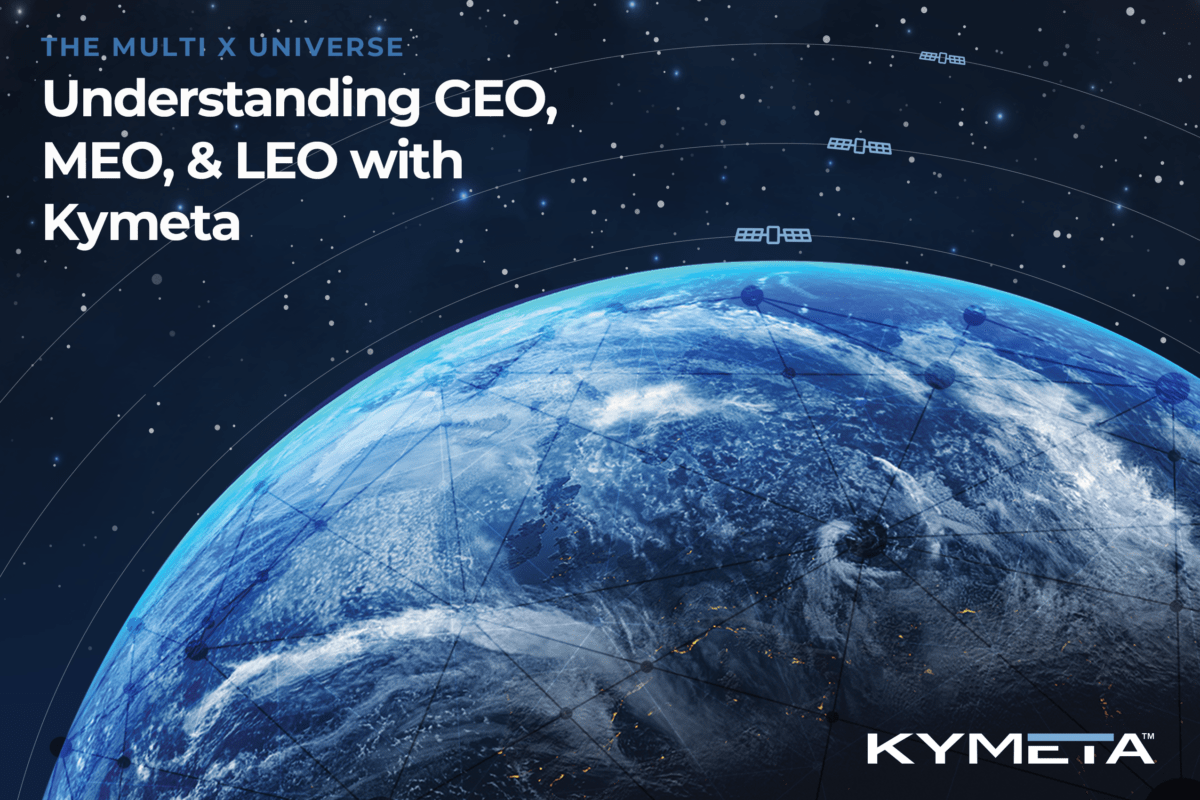The Multi X Universe: Understanding GEO, MEO, and LEO with Kymeta
June Li on May 2, 2024

When it comes to ensuring reliable communication for military, government, public safety, and industrial applications, understanding the strengths of key satellite orbits is crucial. Kymeta’s user terminals are leading the Multi X Revolution with their family of products for LEO (Low Earth Orbit) and GEO (Geostationary Orbit), including the recently launched Osprey™ u8 ‒ Hybrid-GEO-LEO (HGL), which enables users to switch between orbits and networks seamlessly. Let’s explore these orbits and how Kymeta empowers you with unparalleled flexibility, mobility, and resilience in mission-critical situations.
A Refresher on GEO, MEO, and LEO Satellites:
GEO (Geostationary Orbit): Imagine a satellite hovering permanently over the same spot on Earth. That’s GEO! These satellites orbit at a staggering 35,786 kilometers above the equator, matching Earth’s rotation. This creates a constant, broad signal footprint ideal for applications like satellite TV and fixed communication infrastructure. However, the high altitude introduces signal delay, impacting real-time data needs.
MEO (Medium Earth Orbit): Zone lies between GEO and LEO. MEO satellites offer a balance between coverage area and latency, making them well-suited for navigation systems like GPS.
LEO (Low Earth Orbit): LEO satellites are the closest to Earth (160 kilometers to 2,000 kilometers), resulting in the fastest data transmission speeds. This makes them ideal for real-time applications like mobile broadband. However, individual LEO satellites have a smaller coverage area, and their lower orbit shortens their lifespan. LEO constellations require a large number of satellites for continuous coverage.
Orbit |
Description |
Advantages |
Disadvantages |
Applications |
|---|---|---|---|---|
|
GEO (Geostationary Orbit) |
Stays fixed over one spot on Earth |
Broad signal footprint, ideal for fixed applications |
Weaker signal at higher latitudes |
Satellite TV, Fixed Communication |
|
MEO (Medium Earth Orbit) |
Balance between LEO and GEO |
Larger coverage area than LEO, lower latency than GEO |
More complex and expensive than LEO |
Navigation (GPS) |
|
LEO (Low Earth Orbit) |
Closest orbit to Earth |
Fastest data transmission speeds |
Requires a large and constantly maintained constellation of satellites |
Mobile Broadband |
Unleash Unmatched Connectivity with Kymeta
Kymeta’s innovative solutions leverage the power of multiple orbits, including LEO and GEO, to provide unparalleled connectivity for mission-critical applications. Here’s how Kymeta empowers you:
- Unmatched Flexibility: Never miss a beat, anywhere. Kymeta Osprey u8 – HGL seamlessly connects to both LEO and GEO satellite networks, delivering the low latency and high-speed data you need for real-time applications. Gain the information you need, when you need it most, regardless of location.
- Mobility Built In: Unlike bulky, stationary dishes, Kymeta user terminal is designed for mobility. Kymeta’s on-the-move capabilities ensure seamless connectivity no matter how fast you are traveling by land, sea, or air. This is a game-changer for mobile command centers, emergency response teams, and remote industrial operations.
- Resilient Communication: Built to endure, built to connect. Kymeta’s user terminal is constructed to withstand harsh environments. Extreme weather or challenging terrain will not disrupt your critical communication. Kymeta keeps your connection strong when you need it most.
Kymeta: Your Partner in the Multi X Revolution
By leveraging the power of LEO and GEO satellites and the innovative user terminals from Kymeta, you can achieve a new level of reliable and resilient communication, no matter your location or the demands of your mission. With the deployment of the recently launched Osprey u8 ‒ HGL, Kymeta is leading the way providing multi orbit and network solutions.
Explore all Kymeta’s solutions and discover how Kymeta can transform the way you connect.
- Category: Technology